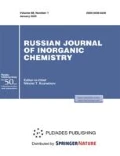Abstract
Effect of heteroatoms in manipulating irontricarbonyl assisted ring openings in heterosubstituted cyclobutenes (HCB) has been studied using DFT. Iron tricarbonyl facilitates the ring cleavage when X = O, S and Se but retards when X = NH, PH. Iron tripod promotes the Hin pathway to Hout in the oxa/thia/selena HCBs. The dominance of iron in bond cleavage is evident through the NLMO study. The case is not very simple in the aza and phospha analog, there are not only a poisoning behavior of iron tripod by enhancing the barrier but also competition prevailing between the catalyst and the hetero lone pairs to determine the torque/regio selective pathways.



Similar content being viewed by others
REFERENCES
D. J. Tantillo and R. Hoffmann, Helv. Chim. Acta 84, 1396 (2001). https://doi.org/10.1021/ja0107935
C. Prathipa and L. Akilandeswari, J. Mol. Model. 22, 266 (2016). https://doi.org/10.1007/s00894-016-3125-7
G. Rousseau and S. Robin, Four-Membered Heterocycles: Structure and Reactivity, inModern Heterocyclic Chemistry, Ed. by J. Alvarez-Builla, J. J. Vaquero, and J. Barluenga, (Wiley-VCH, 2011), p 163.
Four-Membered Heterocycles together with All Fused Systems Containing a Four-Membered Heterocyclic Ring in Comprehensive Heterocyclic Chemistry III, Ed. by A. R. Katritzky, C. A. Ramsden, E. F. V. Scriven, and R. J. K. Taylor, (Elsevier, 2008), Vol. 2, p. 1.
J. P. Synder, J. Am. Chem. Soc. 45, 1344 (1980). https://doi.org/10.1021/jo01295a046
L. E. Fredrich and G. B. Schuster, J. Am. Chem. Soc. 93, 4602 (1971). https://doi.org/10.1021/ja00747a049
H. Yu, W. Chan and J. D. Goddard, J. Am. Chem. Soc. 112, 7529 (1990). https://doi.org/10.1021/ja00177a012
W. Krimse, N. G. Rondon, and K. N. Houk, J. Am. Chem. Soc. 106, 7989 (1984). https://doi.org/10.1021/ja00337a067
K. Rodolf, D. C. Spellmeyer, and K. N. Houk, J. Org. Chem. 52, 3708 (1987). https://doi.org/10.1021/jo00392a046
S. Niwayami, E. A. Kallel, D. C. Spellmeyer, and K. N. Houk, J. Org. Chem. 61, 2813 (1996). https://doi.org/10.1021/jo950884i
M. Jaccob, I. Sheeba Jem, S. Giri, et al., J. Phys. Org. Chem. 24, 460 (2011). https://doi.org/10.1002/Poc.1785
M. E. Kuehne And P. J. Sheeran, J. Org. Chem. 33, 4406 (1968). https://doi.org/10.1021/jo01276a021
M . Walker, B. N. Hietbrink, B. E. Thomas Iv, et al., J. Org. Chem. 66, 6669 (2001). https://doi.org/10.1021/jo010466f
S. Mangelinck, V. V. Speybroeck, P. Vansteenkiste, et al., J. Org. Chem. 73, 5481 (2008). https://doi.org/10.1021/jo800522b
M. E. Jung and Y. M. Choi, J. Org. Chem. 56, 6729 (1991). https://doi.org/10.1021/Jo00024a001
A. P. Marchand, D. Rajagopal, S. G. Bott, et al., J. Org. Chem. 59, 1608 (1994). https://doi.org/10.1021/jo00086a008
M. J. Frisch et al., Gaussian 98, revision A.9 (Gaussian, Pittsburgh, 1998).
A. D. Becke, J. Chem. Phys. 98 1372 (1993). https://doi.org/10.1063/1.464304
C. Lee, W. Yang, and R. G. Parr, Phys. Rev. B 37, 785 (1988). https://doi.org/10.1103/PhysRevB.37.785
P. C. Hariharan and J. A. Pople, Theor. Chim. Acta. 28, 213(1973). https://doi.org/10.1007/BF00533485
P. J. Hay and W. R. Wadt, J. Chem. Phys. 82, 299 (1985). https://doi.org/10.1063/1.448975
C. Gonzalez and H. B. Schlegel, J. Chem. Phys. 90, 2154 (1989). https://doi.org/10.1063/1.456010
J. P. Foster and F. Weinhold, J. Am. Chem. Soc. 102, 7211(1980). https://doi.org/10.1021/ja00544a007
A. D. Reed, L. A. Curtiss, and F. Weinhold, Chem. Rev. 88, 899 (1988). https://doi.org/10.1021/cr00088a005
E. D. Glendening, A. E. Reed, J. E. Carpenter, and F. Weinhold, NBO 3.1 Program Manual (Theoretical Chemistry Institute and Department of Chemistry, University of Wisconsin, Madison, WI, 1988).
W. Cooper and W. D. Walters, J. Am. Chem. Soc. 80, 4220 (1958). https://doi.org/10.1021/ja01549a025
K. B. Wiberg and R. A. Fenoglio, J. Am. Chem. Soc. 90, 3395 (1968). https://doi.org/10.1021/ja01015a017
M. Iranpour, R. Fazaeli, M. S. Sadjadi, et al. Russ. J. Inorg. Chem. 64, 472 (2019). https://doi.org/10.1134/S0036023619040107
Funding
L. A. thanks the University Grants Commission, New Delhi, for the financial assistance through minor research project (no. F-MRP6409/16(SERO/UGC)).
Author information
Authors and Affiliations
Corresponding author
Ethics declarations
The authors declare that they have no conflict of interest.
Rights and permissions
About this article
Cite this article
Prathipa, C., Akilandeswari, L. In the Iron Tricarbonyl Mediated Electrocyclic Ring Opening of 3-Heterocyclobutenes—Does Iron or Heteroatom Decide the Pathway?. Russ. J. Inorg. Chem. 65, 1025–1031 (2020). https://doi.org/10.1134/S0036023620070165
Received:
Revised:
Accepted:
Published:
Issue Date:
DOI: https://doi.org/10.1134/S0036023620070165




